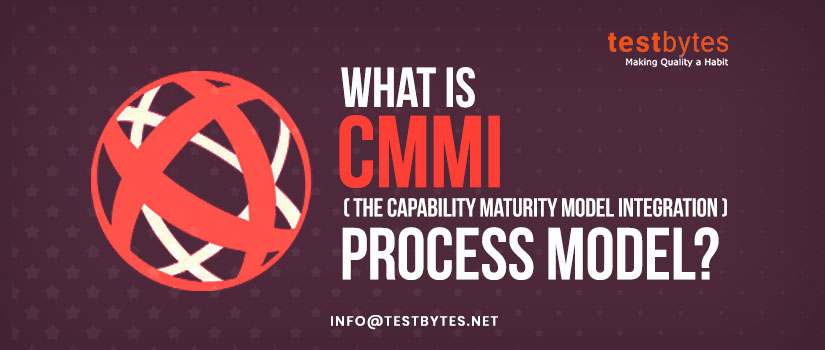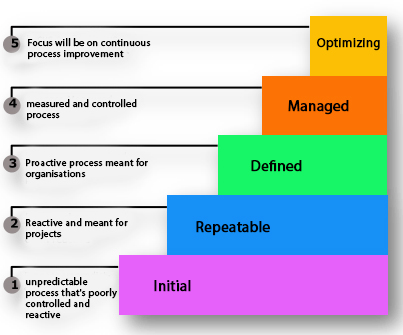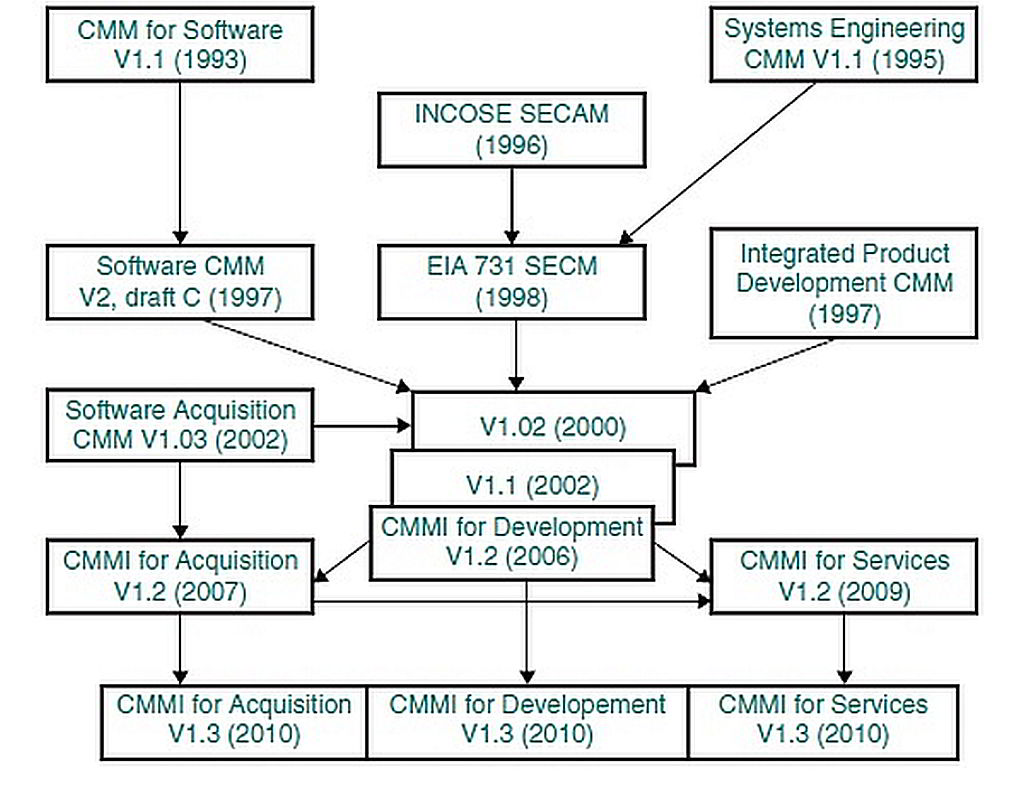
What is CMMI? (Capability Maturity Model Integration): How To Achieve It?
February 16th, 2024

What is CMMI?
CMMI is a process improvement framework that provides organizations with guidelines for developing and refining their processes to improve performance, quality, and efficiency. It offers a structured approach to process improvement by defining a set of best practices that organizations can adopt and tailor to their specific needs.
Established by the Software Engineering Institute at Carnegie Mellon University, it was developed as a process enhancement tool for software development. It is now managed by the CMMI Institute.
CMMI can be applied to product and service development, service establishment, management, and delivery. It helps guide process improvement across a project, division, or entire organization.
CMMI models are used to identify and address essential elements of effective product development and maintenance processes.
What are the 5 levels of CMMI?
One of the defining features of CMMI is its maturity model, which provides a structured framework for assessing and improving an organization’s process maturity. CMMI defines five maturity levels, each representing a different stage in the organization’s journey toward process improvement and excellence.
Maturity Level 1: Initial
At Level 1, organizations have ad hoc, chaotic processes that are often unpredictable and poorly controlled. There is a lack of defined processes, and success depends on individual effort and heroics. Organizations at Level 1 typically struggle with inconsistency, cost and schedule overruns, and high failure rates.
Maturity Level 2: Managed
At Level 2, organizations begin to establish basic processes, discipline, and control. They define and document standard processes for project management, engineering, and support activities. While processes may still be somewhat reactive, there is a focus on planning, tracking, and ensuring that work is performed according to established procedures.
Maturity Level 3: Defined
At Level 3, organizations have well-defined and standardized processes that are tailored to specific projects and organizational needs. There is a focus on process improvement and optimization, with an emphasis on institutionalizing best practices and lessons learned. Processes are proactive and consistently applied across the organization.
Maturity Level 4: Quantitatively Managed
At Level 4, organizations implement quantitative process management practices to control and manage process performance. They collect and analyze data to understand variation, predict outcomes, and make data-driven decisions. There is a focus on continuous measurement and improvement to achieve predictable and stable process performance.
Maturity Level 5: Optimizing
At Level 5, organizations focus on continuous process improvement and innovation. They actively seek out opportunities to improve processes, products, and services through experimentation, innovation, and organizational learning. There is a culture of excellence and a commitment to driving ongoing improvement and innovation throughout the organization.

History And Evolution Of CMMI
The Capability Maturity Model Integration (CMMI) is a process-level improvement training and appraisal program that was developed by the Software Engineering Institute (SEI) at Carnegie Mellon University. It is a methodology used to develop and refine an organization’s software development process. The CMMI model provides organizations with the essential elements of effective processes, which will improve their performance.
- Early 1980s: The concept of a maturity framework for software development processes began to take shape due to the U.S. Department of Defense’s concerns about the quality of software projects.
- 1986: The Software Engineering Institute (SEI) was established by the U.S. Department of Defense at Carnegie Mellon University. The SEI aimed to advance software engineering and quality assurance practices.
- 1987: The SEI introduced the Capability Maturity Model (CMM) for Software (SW-CMM), which outlined five levels of process maturity for software development.
- Late 1990s: Recognizing the need for a more integrated approach that included different aspects of software development and organizational functions beyond software engineering, the SEI began developing the CMM Integration (CMMI).
- 2000: The initial version of CMMI was released, integrating various CMMs into a single improvement framework. This model was designed to be more comprehensive and flexible, allowing for customization to meet the needs of different organizations.
- 2002: CMMI Version 1.1 was released, providing minor updates and clarifications based on user feedback.
- 2006: CMMI Version 1.2 was introduced, offering significant improvements in usability, clarity, and consistency.
- 2010: CMMI Version 1.3 was released, which further refined the model and introduced more flexibility in its application across different areas, including services and development.
- 2018: CMMI V2.0 was launched, focusing on performance improvement, increasing the model’s relevancy in today’s agile and competitive business environment.
Evolution of CMMI

Key Components of CMMI
CMMI is structured around a set of key components that define its framework and guide process improvement. These components include:
- Maturity Levels: CMMI defines five maturity levels that organizations can achieve as they improve their processes. These levels, ranging from Level 1 (Initial) to Level 5 (Optimizing), represent increasing process maturity and capability levels.
- Process Areas: CMMI identifies areas organizations should focus on to improve performance. These process areas cover various aspects of project management, engineering, and support functions, such as requirements management, project planning, configuration management, and process improvement.
- Goals and Practices: Each process area in CMMI defines specific goals that organizations should strive to achieve and practices they should implement to meet them. These goals and practices serve as benchmarks for evaluating the effectiveness of an organization’s processes and identifying areas for improvement.
- Appraisal Method: CMMI provides an appraisal method for evaluating an organization’s adherence to its defined processes and assessing its maturity level. This appraisal method involves a structured assessment process conducted by trained appraisers to determine the organization’s level of process maturity and identify areas for improvement.
Different and Important CMMI Models
CMMI is not a one-size-fits-all approach; instead, it offers multiple models tailored to different domains and organizational needs. These models provide a structured framework for organizations to benchmark their current practices, identify areas for improvement, and establish a roadmap for achieving higher levels of maturity. Some of its key models include:
CMMI for Development (CMMI-DEV)
CMMI-DEV is one of the most widely used CMMI models and is specifically tailored for organizations involved in software and systems development. It provides a comprehensive set of best practices for managing and improving the development lifecycle, from requirements management to product delivery and maintenance. Some key process areas covered in CMMI-DEV include:
- Requirements Management
- Project Planning
- Configuration Management
- Supplier Agreement Management
- Measurement and Analysis
- Process and Product Quality Assurance
- Verification and Validation
CMMI for Services (CMMI-SVC)
CMMI-SVC is designed for organizations primarily delivering services, such as consulting firms, IT service providers, and outsourcing companies. It focuses on establishing and improving processes related to service delivery, customer satisfaction, and service management. Its key process areas include:
- Service System Development
- Service Delivery
- Service System Transition
- Service System Acquisition
- Service System Maintenance
- Supplier Agreement Management
- Process and Service Delivery Management
CMMI for Acquisition (CMMI-ACQ)
CMMI-ACQ is tailored for organizations involved in acquisition and procurement activities, such as government agencies, defense contractors, and purchasing departments. It provides guidance on managing the acquisition lifecycle, from soliciting requirements to accepting and managing supplier contracts. Its key process areas include:
- Acquisition Requirements Development
- Acquisition Planning
- Acquisition and Technical Management
- Acquisition Verification and Validation
- Acquisition Evaluation
- Supplier Agreement Management
- Acquisition Process Management
These are just a few examples of the CMMI models available, each tailored to specific domains and organizational contexts. Organizations can choose the model that best aligns with their business objectives, industry requirements, and process improvement goals.
CMMI is both a process model and a behavioral model. It can be used to manage the logistics of refining performance by creating determinate standards; it can also develop a structure for boosting prolific and effective behavior throughout the system.
To conclude, the CMMI model is a pool of dependable best practices that help improve the quality, standards, and efficiency of software development processes. It includes various process areas like project planning, configuration management, etc.
Why is the Capability Maturity Model Integration (CMMI) Model important?
The CMMI model is being widely used by organizations to streamline and enhance their software development processes. It can also ensure that an organization will be able to complete the software within the given timelines and the allocated resources.
Being developed in the US defence sector, it is being widely trusted and used by organizations worldwide. Here are a few benefits of Capability Maturity Model Integration:
Consistency
CMMI radically enhances project predictability and consistency. It enhances the consistency of the complete process, thereby increasing the steadiness and reliability of the project.
Cost Saving
CMMI assists in early and more effective error detection and hence reduces the cost of rework considerably. It also reduces the cost burden because of schedule variability. It assists in enhanced cost predictability. The overall CMMI model plays a major role in cost savings in the software development process.
Self-Improvement
Organizations using CMMI are easily able to differentiate themselves by naturally improving process management and are becoming more competitive. Adopting CMMI is gradually becoming a benchmark for improved and enhanced process management.
Market demand
CMMI offers a set of industry best practices that enable the teams to reap the maximum benefit of it. Organizations are using it to best meet their customer’s demands. Also, the growing popularity of the process has given it a competitive edge and has established it as a benchmark for more efficient and streamlined software development.
Performance demand
CMMI helps improve the existing organizational processes and standards by analyzing their faults and overcoming them. Hence, CMMI can largely increase the performance of the processes. With extensive competition and high-performance demand, CMMI is gradually becoming a hot favorite of software organizations worldwide.
Process improvement
CMMI consists of a set of best practices or process management. Leveraging CMMI ensures process improvement. It includes 25 different process areas to provide an all-inclusive business process enhancement solution. The process areas in CMMI include 2 kinds of goals, 2 practices, and a large amount of useful data.
How To Implement CMMI In The Testing Process?
Implementing the Capability Maturity Model Integration (CMMI) in the testing process is a strategic approach to enhancing the quality and effectiveness of testing activities within an organization. Here are some key steps to effectively implement CMMI in the testing process:
- Understand CMMI Framework: Before embarking on implementation, it’s essential to have a solid understanding of the CMMI framework, including its maturity levels, process areas, goals, and practices relevant to testing activities.
- Assess Current Testing Processes: Conduct a thorough assessment of the current testing processes within the organization to identify strengths, weaknesses, and areas for improvement. This assessment will serve as a baseline for measuring progress and identifying specific areas where CMMI practices can be implemented.
- Define Testing Goals and Objectives: Clearly define the goals and objectives of testing within the context of the organization’s overall business objectives. Establish measurable targets for improving testing processes, such as increasing test coverage, reducing defects, and improving time-to-market.
- Tailor CMMI Practices: Tailor the CMMI practices to suit the organization’s specific testing needs and objectives. Identify relevant process areas and practices from the CMMI framework that can be implemented or adapted to improve testing processes.
- Develop Testing Processes: Develop and document standardized testing processes based on the selected CMMI practices. Clearly define roles, responsibilities, workflows, and guidelines for conducting testing activities, including test planning, test design, test execution, defect management, and test reporting.
- Implement Best Practices: Implement best practices identified from the CMMI framework to improve testing effectiveness and efficiency. This may include practices related to requirements management, test case development, test automation, peer reviews, and continuous improvement.
- Training and Skill Development: Provide training and skill development opportunities for testing professionals to ensure they have the necessary knowledge and expertise to implement CMMI practices effectively. Foster a culture of learning and continuous improvement within the testing team.
- Monitor and Measure Progress: Continuously monitor and measure progress towards achieving the defined testing goals and objectives. Use key performance indicators (KPIs) to track metrics such as defect density, test coverage, test execution time, and customer satisfaction.
- Iterative Improvement: Continuously review and refine testing processes based on feedback, lessons learned, and changing business needs. Embrace a culture of iterative improvement to drive ongoing enhancements in testing effectiveness and maturity.
SCAMPI or Standard CMMI Appraisal Method for Process Improvement
Standard CMMI Appraisal Method for Process Improvement is a CMMI-endorsed assessment method that is used by CMMI society. This process is clearly defined in the SCAMPI Method Definition Document inside the CMMI appraisal reference documents. It is divided into 3 classes: Class A, B, and C.
- SCAMPI A: The most widely used appraisal method is SCAMPI A, which is generally used after multiple processes have been executed. SCAMPI A is used to set benchmarks for organizations and provides official ratings. An on-site, certified lead appraiser performs it.
- SCAMPI B: It is used to discover a target CMMI maturity level and is less official than SCAMPI A. It is also used to forecast success for evaluated practices and to evaluate where the business stands in the maturity process.
- SCAMPI C: SCAMPI C is smaller, a supplier, and cheaper than SCAMPI A or B. It evaluates a business’s established practices and identifies how to align them with CMMI practices. It can address managerial issues or smaller processes. It is riskier than SCAMPI A and B but is more cost-effective.
Involvement of CMMI In Software Testing?
Implementing CMMI (Capability Maturity Model Integration) in software testing offers numerous benefits and addresses several key needs within the quality assurance and testing processes. Here’s why CMMI is important for software testing:
- Enhanced Quality Assurance: CMMI provides a structured framework for quality assurance processes, ensuring that software testing is thorough, systematic, and aligned with the project’s objectives and requirements.
- Process Standardization: It helps in standardizing the testing processes across the organization, leading to consistency in how testing is planned, executed, and managed.
- Continuous Improvement: CMMI emphasizes continuous process improvement, allowing organizations to regularly evaluate and enhance their testing processes for better efficiency and effectiveness.
- Risk Management: Implementing CMMI helps identify potential risks early in the testing phase, enabling timely mitigation strategies to be deployed, which in turn reduces the likelihood of project delays or failures.
- Stakeholder Confidence: Achieving a certain CMMI maturity level signals to clients, stakeholders, and regulatory bodies that an organization follows industry-best practices in software testing, thereby boosting their confidence in the product’s quality.
- Defect Reduction: By following a structured approach to testing, organizations can significantly reduce the number of defects in the software, leading to higher quality products.
- Efficiency and Productivity: CMMI helps streamline the testing process, reducing redundancy and waste, which in turn improves the efficiency and productivity of the testing team.
- Benchmarking and Performance Measurement: It provides metrics and benchmarks for evaluating the performance of testing processes, aiding in the identification of areas for improvement.
- Competitive Advantage: Organizations that implement CMMI for software testing can gain a competitive edge by demonstrating their commitment to quality and process excellence.
- Alignment with Business Objectives: CMMI ensures that testing processes are aligned with the organization’s business objectives, contributing to the overall strategic goals of the company.
How to implement CMMI in the testing process?
The implementation of CMMI to the testing process is very limited. But recently software testing companies have discovered that they can implement CMMI to their testing process to meet the crunched deadlines and to deliver the better-tested product.
Result?
- Better quality of deliverables.
- Enhanced customer satisfaction.
- Assists in cost-saving.
- Assures stability and high performance of the deliverables.
Let us now learn how we can implement CMMI to testing process:
- Pick up the trained staff members
- Create groups for the testing process
- Refer to CMMI consultants
- Implement testing processes
- Pick the apt tools
- Implement the CMMI model to the testing process
- Gather client’s feedbacks
- Enhance the implemented practices.
Test management using CMMI
- Identify validation criteria for the integration environment
- Create an integration environment
- Create verification environment
- Define test methods
CMMI tools
There are various CMMI tools available in the market. Choice of these tools depends on the business’s needs. During the Maturity level 2 or 3, you can take the help of your CMMI consultant to design customized tools. You might have to consider the following tools:
- Bug tracker
- Project and document management
- Requirement and design management
- Metrics tools
- Estimation
- Integration application
- Decision and analysis tools
Conclusion:
CMMI is a powerful framework for process improvement that offers organizations a structured approach to enhancing their performance, quality, and efficiency.
By defining best practices, benchmarking maturity levels, and providing guidance for process improvement, CMMI helps organizations achieve their business objectives and maintain a competitive edge in today’s dynamic marketplace. Whether in software development, healthcare, aerospace, or any other industry, organizations can benefit from adopting CMMI and embracing a culture of continuous improvement and excellence.
FAQs
Application of CMMI Across Industries
While CMMI has its origins in software engineering, its principles and practices are applicable to a wide range of industries and domains. Organizations in sectors such as aerospace, defense, healthcare, finance, automotive, and telecommunications have successfully adopted CMMI to improve their processes and achieve their business objectives.
In the aerospace and defense industry, for example, CMMI is widely used to ensure the safety, reliability, and compliance of complex systems and technologies. In healthcare, CMMI helps organizations enhance patient care, optimize clinical processes, and comply with regulatory requirements. In finance, CMMI enables organizations to manage risks, improve operational efficiency, and deliver innovative products and services to customers.
What is the difference between CMMI level 5 companies and CMMI level 3 companies?
| Feature | CMMI Level 3 Companies | CMMI Level 5 Companies |
|---|---|---|
| Focus | Defined Processes | Continuous Process Improvement |
| Processes | Standardized and documented according to the organization’s set of standard processes. | Optimized and continuously improved based on quantitative data to achieve the organization’s business objectives. |
| Goals | Establish, use, and maintain a set of defined processes for projects. | Focus on process optimization and reducing variability in process performance to improve quality and efficiency. |
| Quantitative Management | Limited use of quantitative process performance data for process management. | Extensive use of quantitative data to manage and optimize processes. |
| Innovation | Focus on establishing a set of standard processes and ensuring projects adhere to them. | Emphasis on process innovation and making continuous process improvements based on quantitative performance data. |
| Performance Management | Projects are managed more qualitatively, with some quantitative performance measures used. | The performance of processes is managed quantitatively, aiming for predictable process performance across the board. |
| Optimization Techniques | Optimization efforts are not the primary focus. | Active and continuous process optimization efforts, using advanced statistical methods. |
| Process Standardization | Processes are well-defined and understood across the organization. | Processes are not only well-defined but also subject to continuous improvement efforts to enhance performance. |
| Capability Improvement | Focus on establishing a consistent process across projects. | Focus on continuous improvement and optimization of processes to achieve higher quality and efficiency. |
| Outcome Predictability | Projects are more predictable than at lower levels, but there is less emphasis on optimization. | High predictability of project outcomes due to optimized and controlled processes. |
CMMI Level 3 is characterized by the organization having standardized and defined processes that are understood and used throughout. At this level, processes are well-documented, and projects are executed according to these processes.
CMMI Level 5, on the other hand, goes beyond establishing standardized processes to focus on continuous process improvement and optimization based on quantitative data. Organizations at Level 5 systematically use data and statistical methods to eliminate inefficiencies and improve process performance, leading to highly predictable and efficient outcomes.
Which is better, CMMI or ISO?
Where To Learn CMMI?
Learning Capability Maturity Model Integration (CMMI) involves understanding its framework, principles, and how to apply them to improve processes within an organization. Here’s a structured approach to learning CMMI:
1. Understand the Basics
- Read the CMMI Model: Start with the latest version of the CMMI model, such as CMMI for Development, CMMI for Services, or CMMI for Acquisition, depending on your area of interest.
- Official CMMI Website: Visit the CMMI Institute’s website for resources, official guides, and introductory materials.
2. Take Formal Training
- CMMI Courses: Enroll in CMMI training courses offered by the CMMI Institute or its authorized training providers. These courses range from introductory to advanced levels.
- Workshops and Seminars: Attend workshops and seminars on CMMI. These are often offered at industry conferences and can provide practical insights and networking opportunities.
3. Get Practical Experience
- Join a CMMI Project: Gain experience by participating in a project within an organization that is implementing or has implemented CMMI. Hands-on experience is invaluable.
- Case Studies: Study case studies of organizations that have successfully implemented CMMI. This can provide practical insights into the challenges and benefits of applying CMMI.
4. Engage with the CMMI Community
- Forums and Discussion Groups: Join CMMI forums and discussion groups online. Engaging with the community can provide support, answer questions, and offer advice based on real-world experience.
- CMMI Conferences: Attend CMMI conferences to learn from experts, meet practitioners, and stay updated on the latest developments and best practices.
5. Read Books and Articles
- CMMI Books: There are several comprehensive books on CMMI that cover its methodology, application, and case studies.
- Research Articles: Academic and industry publications can provide deeper insights into specific aspects of CMMI and its implementation.
6. Certification
- Consider Certification: After gaining a solid understanding and practical experience, consider pursuing CMMI certification. Becoming a CMMI-certified professional can validate your knowledge and skills.
7. Continuous Learning
- Stay Updated: CMMI models and best practices evolve. Stay informed about the latest versions and updates to the CMMI model by regularly visiting the CMMI Institute website and participating in continued education opportunities.
Additional Resources
- CMMI Appraisals: Understanding the appraisal process can provide insights into how organizations are evaluated against the CMMI standards. Consider learning about the different types of appraisals (e.g., SCAMPI A, B, C).
Learning CMMI is a journey that combines theoretical knowledge with practical application. Engaging with the material, the community, and real-world projects is key to deeply understanding how to effectively implement CMMI practices in an organizational setting.


 Software Testing Events
Software Testing Events App Testing
App Testing Web App Testing
Web App Testing Game Testing
Game Testing Automation Testing
Automation Testing Load Testing
Load Testing Security Testing
Security Testing Performance Testing
Performance Testing Hire a Tester
Hire a Tester






